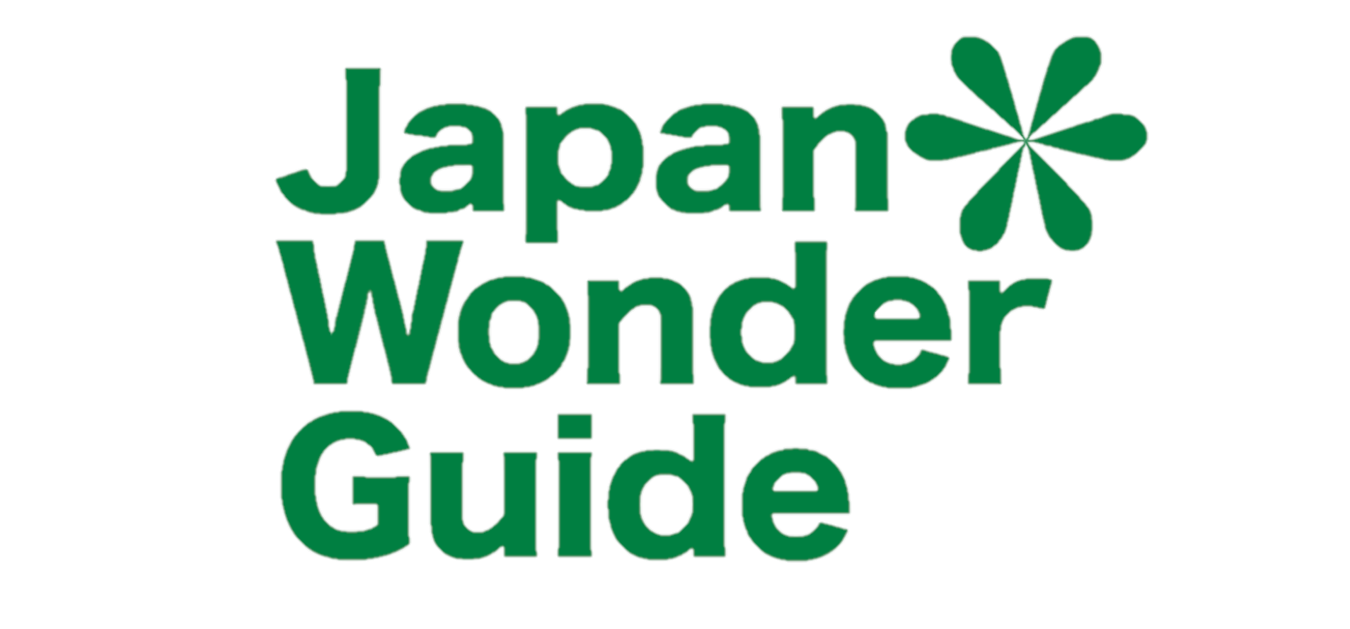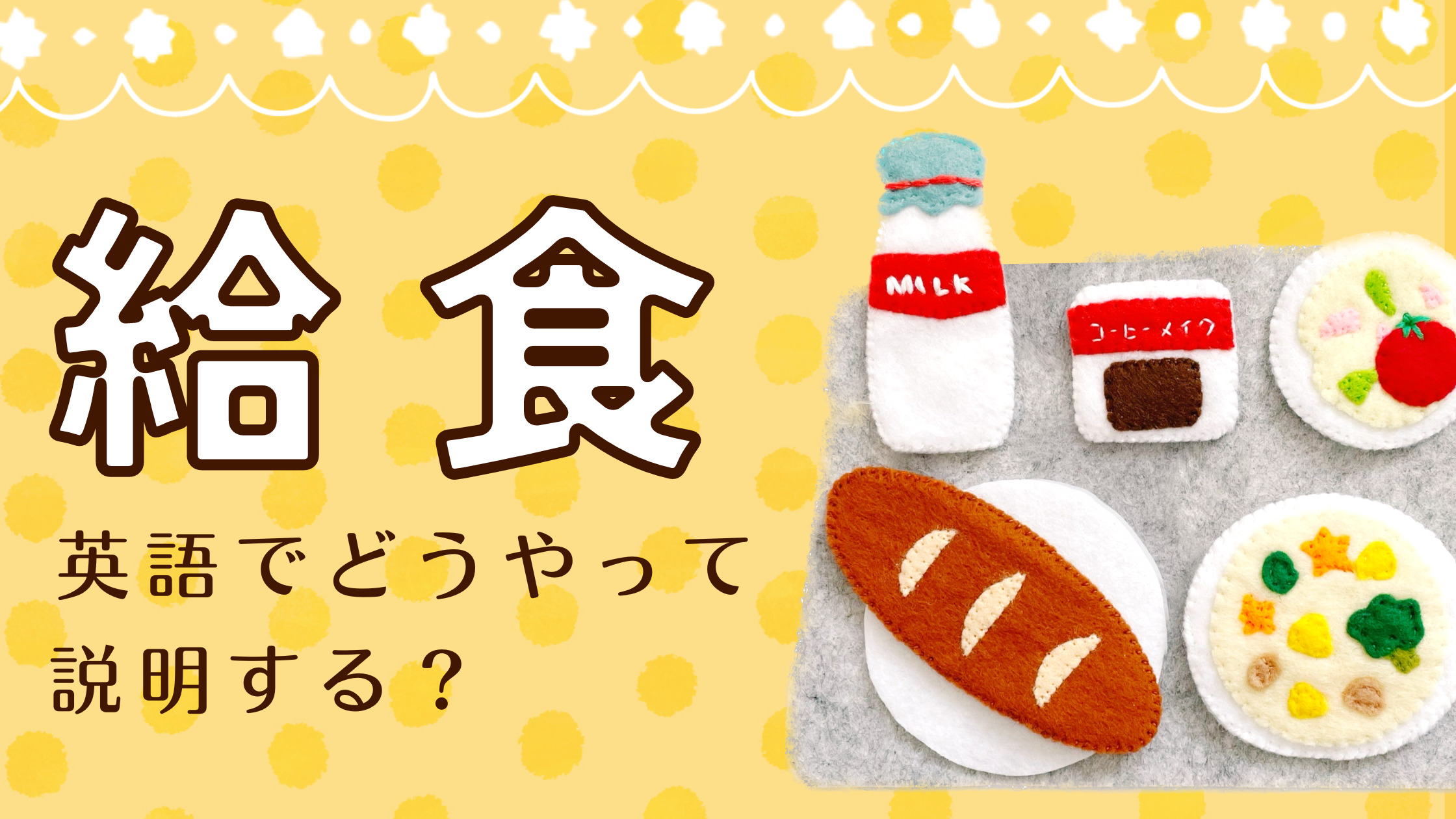日本の小中学校では毎日お昼になると「給食」が提供されます。子供たちの中には1日の学校生活の中でこれを一番楽しみにしている子もいます。
実は日本の給食は、海外でも珍しい特徴が多くあります。季節や栄養をしっかり配慮した給食メニューや、給食当番制などが良い例です。
この記事では、日本の給食や、その歴史、地域の珍しい給食など、日本の給食を英語で説明していきます。
英語の記事はこちら:


【この記事を書いているのは…】
石井 政章(いしい まさあき)
元ホテルマンです。リゾートホテル、シティホテルで主にフロントスタッフとして働いていました。
ホテルで働こうと思ったきっかけは、海外が好きで英語を活かしたいのと人を喜ばせたいという想いがあったからです。
現在は退職しWebライターとして活動しています。
「給食」を英語で説明する
Kyushoku is served in elementary and junior high schools throughout Japan and is cooked lunches that are brought to the classrooms for each class.
給食は全国の小中学校で提供され、調理された昼食は各クラスの教室に運ばれます。
Every day, several students take turns serving lunch on a daily or weekly basis and rationing lunches for the entire class.
毎日、何人かの生徒が日替わりまたは週替わりで給食の準備を担当し、クラス全員に配膳します。
The school lunch menu changes daily and includes a wide variety of dishes.
学校給食のメニューは日によって変わり、種類も豊富です。
Ingredients used in the kyushoku lunches are well-considered. In order to provide safe and secure kyushoku lunches to the children, the school takes various aspects into consideration.
給食に使われる食材はよく考えられています。生徒に安心で安全な給食を提供するため、学校は様々なことを考慮しています。
Many of the ingredients used in kyushoku are domestically produced and local, in order to familiarize the children with the ingredients of their own country and region.
自分の住んでいる国や地域に親しみを持ってもらうため、給食に使われている多くの食材は国内産または地元のものを使っています。
The role of kyushoku is vital, as it provides nutritional support to students who are too busy to have breakfast and provides them with proper knowledge about food.
忙しくて朝ごはんを食べられない学生の栄養補給や、食に関する正しい知識を提供するなど、給食の役割はとても重要です。
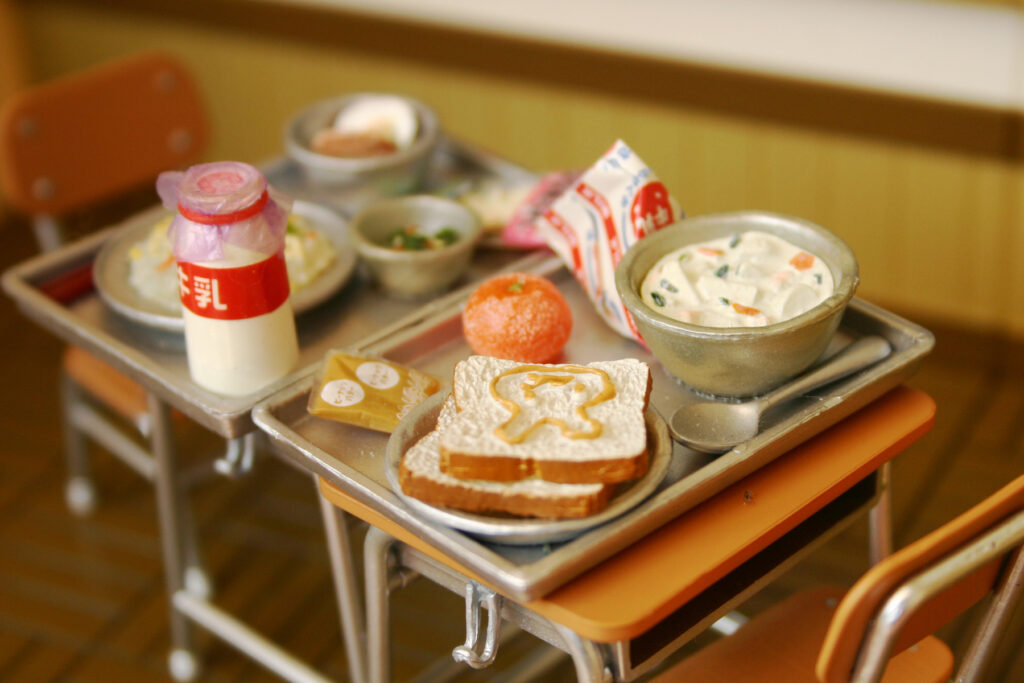
給食の歴史を英語で説明する
The kyushoku system started in 1889 when a municipal elementary school in Tsuruoka City, present-day Yamagata Prefecture, offered a set meal of rice balls, grilled fish, and pickles to children in need for free at lunchtime.
給食制度は、明治22年(1889)、現在の山形県鶴岡市の市立小学校がおにぎり、焼き魚、漬物の定食を、昼食に困っている子どもたちに無料で提供したのが始まりです。
Later, in 1923, school lunches were encouraged by the government to improve children’s nutrition, but as World War II approached, school lunches were abolished due to a shortage of ingredients.
その後、1923年、政府は子どもたちの栄養改善のために学校給食を奨励しましたが、第二次世界大戦が近づくと、食材の不足により学校給食は中止されました。
After the war, Japan was suffering from food shortages, and poor nutrition for children became a serious problem.
戦後、日本は食糧不足に苦しみ、子どもたちの栄養不足が深刻な問題になりました。
In response to a growing voice among the people to revive school lunches in an attempt to overcome this situation, the kyushoku system was resumed.
この状況を打破するため、学校給食を復活させたいという国民の声を受けて、給食制度が再開されました。
In 1954, a law on school lunches was officially enacted, and the school lunch system spread nationwide.
1954年、学校給食法が正式に制定され、学校給食制度が全国に広がりました。
地域ごとの給食を英語で紹介する
北海道
At elementary schools in Shibetsu Town, Hokkaido, salmon roe, a luxury Japanese food, appears in school lunches only once a year.
北海道の標津町(しべつちょう)の小学校では、日本の高級食材であるイクラが給食に1年に一度だけ登場します。
Shibetsu is known as a sacred place for salmon, having once boasted the highest catch of salmon in Japan and so therefore the local fishermen and fishermen’s association provides free salmon roe to the local children so that they can become more familiar with the salmon of Shibetsu.
標津町はかつて鮭の漁獲高日本一を誇った鮭の聖地として知られており、そのため地元の漁師や漁協では、標津の鮭に親しんでもらうために、地元の子どもたちに無料でいくらを提供しています。
On November 11 that is designated as “Salmon Day” in Japan, Shibetsu Town has been serving salmon roe in kyushoku on that day as “Hometown School Lunch Day” for years.
11月11日の鮭の日に、標津町は「ふるさと給食」として何年もイクラを給食で出しています。

青森
In Aomori, a major producer of apples in Japan, apples often appear on the school lunch menu.
日本一のりんごの産地である青森県では、学校給食のメニューによくりんごが登場します。
Apples are served as a dessert, or as a processed product, and bread filled with cubes of apples boiled in sugar. In fact, it is almost rare for apples to not make an appearance on the menu at least a few times a week!
りんごはデザートとして、あるいは加工品として提供されるほか、りんごパン(砂糖で煮た角切りりんごが入ったパン)が提供されます。実際、週に数回以上りんごがメニューに登場しないことは、ほとんどないくらいです。
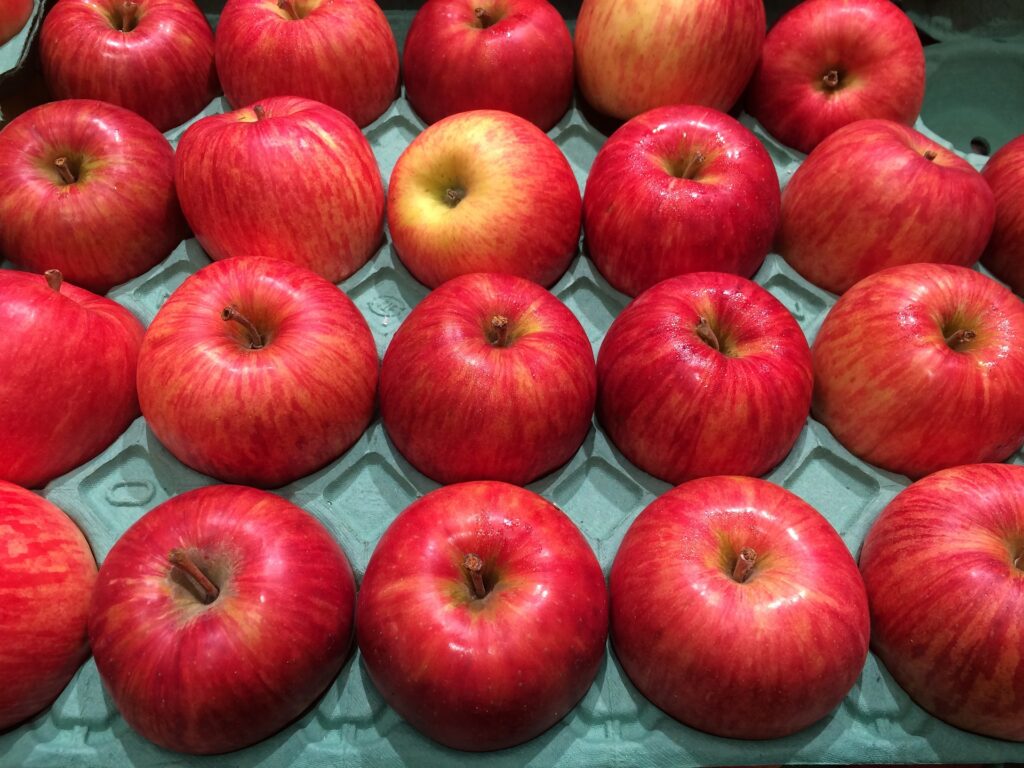
愛媛
Ehime is one of the largest producers of mandarin oranges in Japan, and Kyushoku lunchtime in Ehime always seems to have mandarin oranges on the menu.
愛媛は日本有数のみかんの産地で、愛媛の給食の時間には必ずみかんのメニューがあるようです。
One of the most surprising dishes is “Mandarin orange rice”. In Japan, oranges are usually eaten as they are or used as a dessert ingredient, but in Ehime, they cook rice with mandarin orange juice instead of soup stock!
中でも驚くのは、「みかんごはん」です。日本ではみかんはそのまま食べるか、デザートの材料にするのが一般的ですが、愛媛では出汁の代わりにみかんの果汁でご飯を炊くんです!
They also serve a juice mixture of mandarin and iyokan (Citrus Iyo) as a school lunch drink.
また、給食の飲み物として、みかんと伊予柑を混ぜたジュースを出しています。
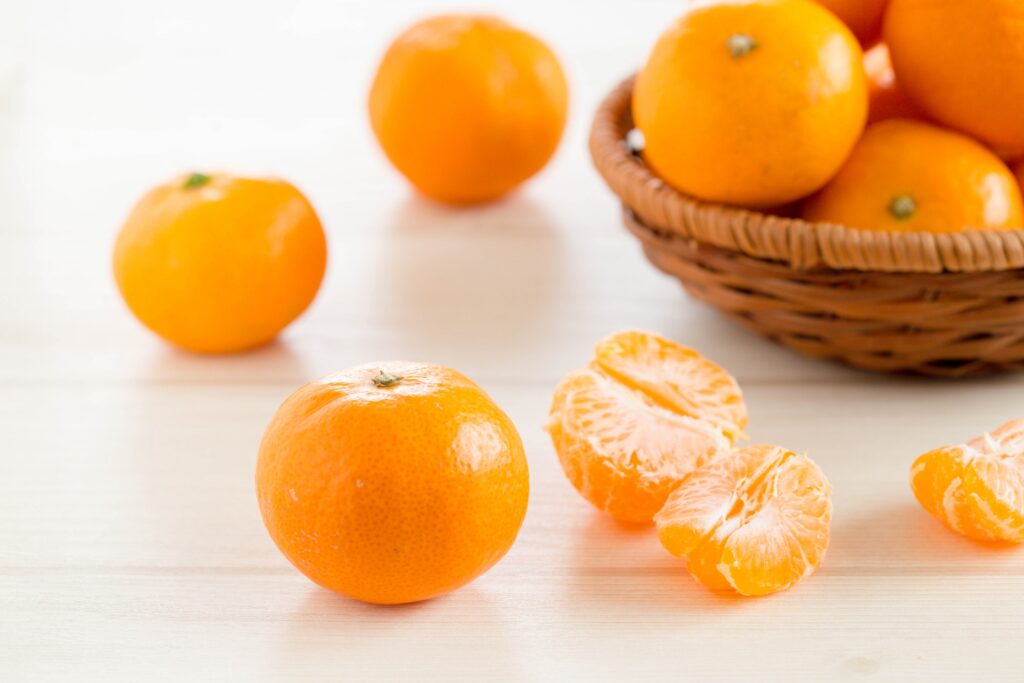
まとめ
今回は日本の学校給食と有名なご当地メニューについて解説いたしました。
英語で学校給食について説明するときは、ぜひ参考にしてみてください。
あわせて読みたい
ガイドコミュニティ・JapanWonderGuideに参加しませんか?

JapanWonderGuide(JWG)は「日本のガイドの質を世界一に」をスローガンに掲げるガイドコミュニティです。2020年から活動を開始し、全国通訳案内士等を中心に、現在は、2,000名を超えるコミュニティとなっております。
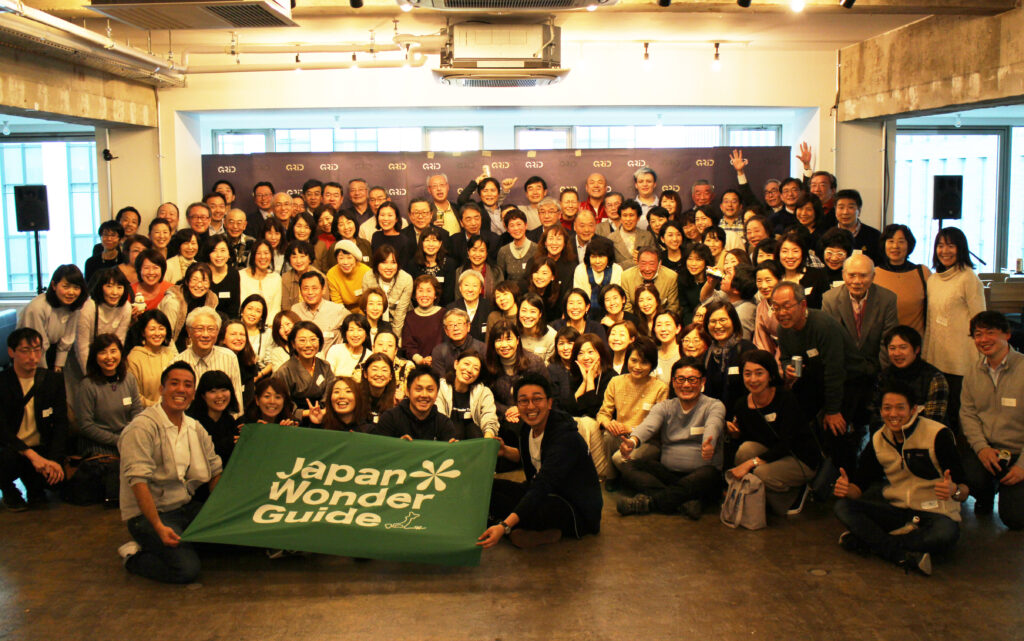
JWGの有料会員(KNOTTER)にご登録いただくと、月額1,000円(税込1,100円)で、ガイディングやビジネスに活きる知識・スキルが身につくE-Learningが受講し放題!ガイドのスキルアップに特化した研修動画を、お好きなだけ、無料でご視聴いただけます。
さらに、KNOTTERになると、通訳案内士が5年ごとに必ず受講しなければならない「通訳案内研修」を、オンラインで、無料でご受講いただけます。そのほか、下見やツアー時に割引/無料でご入場いただける優待施設のご利用や、人気観光施設の最新情報や裏話をお届けするJWG Live!の見逃し配信、各研修の割引など、様々な特典をご利用いただけます。
有料、無料会員様ともに研修やイベント情報など、ガイドに役立つ内容がたっぷり詰まったメルマガを月に2回お届け。また、ガイド仲間を見つけ、交流できるFacebookグループにもご招待!情報交換の場としてお使いください。
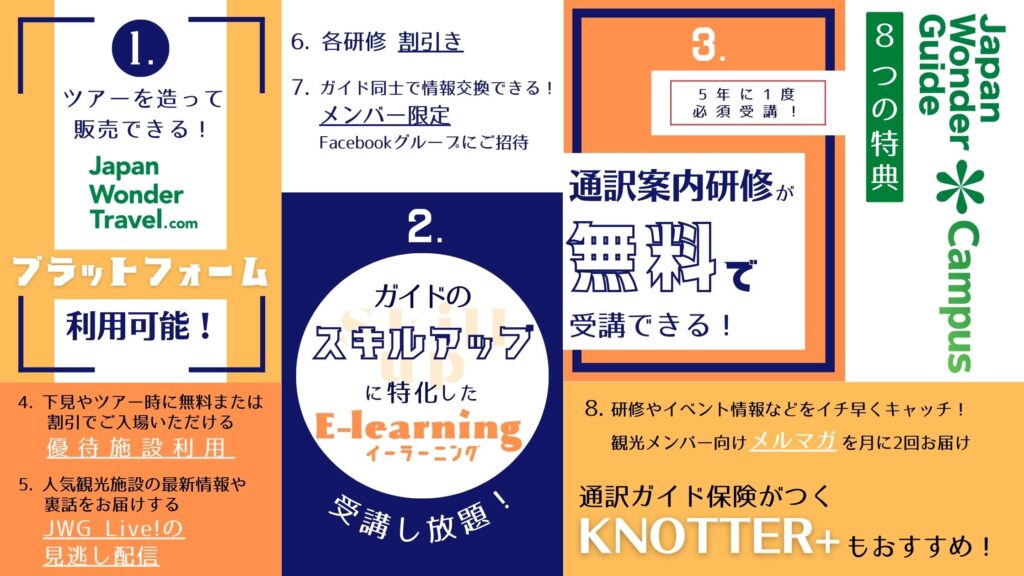
| フリーメンバー | KNOTTER | KNOTTER+ | |
| 料金 | 無料 | 月額1,000円 (税込1,100円) | 年間14,000円※ (税込15,400円) |
| 期間 | 無期限 | 毎月自動更新 | 2023年8月31日まで |
| ①Japan Wonder Travel プラットフォーム利用 | ○ | ○ | ○ |
| ➁メンバー限定Facebookグループご招待 | ○ | ○ | ○ |
| ③メンバー向けメルマガ受信 | ○ | ○ | ○ |
| ④JWG Live!見逃し配信 | △ | ○ | ○ |
| ⑤優待施設利用 | – | ○ | ○ |
| ⑥JWG主催研修割引 | – | ○ | ○ |
| ⑦通訳案内研修 | – (3,500円) | 無料 | 無料 |
| ⑧E-learning動画配信 | 有料 | 無料 | 無料 |
| ⑨通訳ガイド保険 | – | – | ○ |
※KNOTTER+の会費は加入月によって変動します
★通訳ガイド保険がついたKNOTTER+もご用意しております。資格の保有の有無に関わらず、通訳案内業務が補償の対象となりますので、どなたでも安心してガイドのお仕事をしていただけます。
インバウンド復活の兆しも少しずつ見えてきました。ぜひこの機会にご検討ください。
JWGで、日本の観光を一緒に盛り上げていきませんか?
